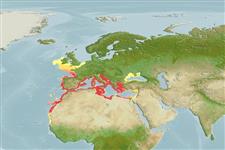Environment: milieu / climate zone / depth range / distribution range
Ecology
Marine; demersal; depth range 15 - 400 m (Ref. 6763). Subtropical; 62°N - 16°N, 19°W - 37°E
Eastern Atlantic and Mediterranean Sea.
Length at first maturity / Size / Weight / Age
Maturity: Lm 15.8, range 17 - 18 cm
Max length : 56.4 cm TL male/unsexed; (Ref. 86700); common length : 22.0 cm TL male/unsexed; (Ref. 3397); max. published weight: 940.00 g (Ref. 40637)
The shoulder spines can inflict, painful stings. Usually found buried in the sand or mud. Equipped with an acoustic apparatus that generates both acoustic and electric pulses. Electric discharge activity shows two temporal patterns: 1) reflexive discharges of short duration (milliseconds), elicited by mechanical stimulation, and 2) those of much longer duration (several seconds) observed only during the summer spawning period (Ref. 10011). Low-frequency spontaneous discharge activity (5-10 Hz), with a sexual dimorphism in discharge amplitude is also said to exist. This species suggestively represents a transitional form in the evolution of electric organs in fishes (Ref. 10577). Oviparous, eggs, larvae and juveniles are pelagic (Ref. 6763). Utilized fresh (Ref. 9987).
Roux, C., 1990. Uranoscopidae. p. 897-898. In J.C. Quero, J.C. Hureau, C. Karrer, A. Post and L. Saldanha (eds.) Check-list of the fishes of the eastern tropical Atlantic (CLOFETA). JNICT, Lisbon; SEI, Paris; and UNESCO, Paris. Vol. 2. (Ref. 7366)
IUCN Red List Status (Ref. 130435: Version 2024-2)
Human uses
Fisheries: minor commercial; gamefish: yes
Tools
Special reports
Download XML
Internet sources
Estimates based on models
Preferred temperature (Ref.
123201): 11.2 - 17, mean 14.2 °C (based on 228 cells).
Phylogenetic diversity index (Ref.
82804): PD
50 = 0.5000 [Uniqueness, from 0.5 = low to 2.0 = high].
Bayesian length-weight: a=0.01202 (0.00979 - 0.01477), b=3.04 (2.98 - 3.10), in cm total length, based on LWR estimates for this species (Ref.
93245).
Trophic level (Ref.
69278): 4.4 ±0.70 se; based on food items.
Generation time: 7.4 ( na - na) years. Estimated as median ln(3)/K based on 2
growth studies.
Resilience (Ref.
120179): Medium, minimum population doubling time 1.4 - 4.4 years (tm=2; K=0.1-0.2).
Fishing Vulnerability (Ref.
59153): High vulnerability (56 of 100).
🛈
Nutrients (Ref.
124155): Calcium = 69.2 [40.3, 127.0] mg/100g; Iron = 1.04 [0.66, 1.74] mg/100g; Protein = 19 [18, 20] %; Omega3 = 0.445 [0.303, 0.666] g/100g; Selenium = 30.9 [15.8, 60.3] μg/100g; VitaminA = 26.2 [9.2, 80.2] μg/100g; Zinc = 0.603 [0.430, 0.869] mg/100g (wet weight); based on
nutrient studies.
